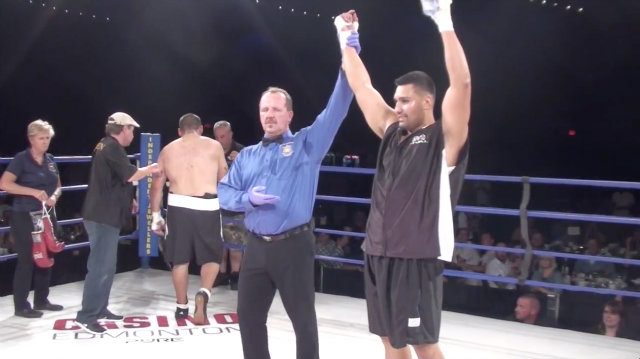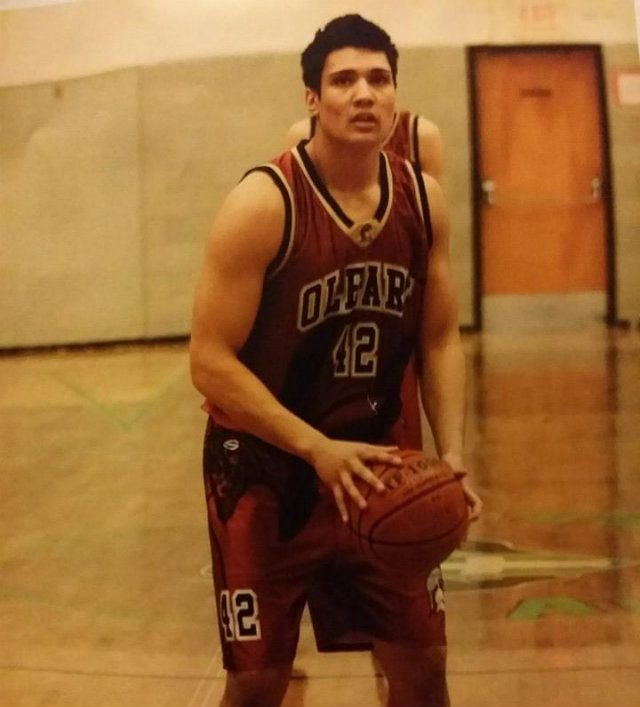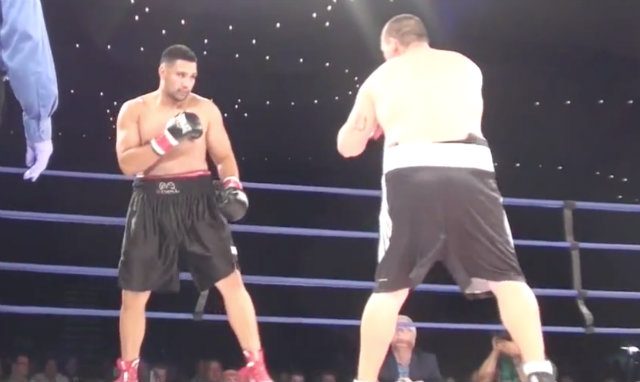SUMMARY
This is AI generated summarization, which may have errors. For context, always refer to the full article.

MANILA, Philippines – Forty-eight seconds.
Stan Surmacz-Ahumada had waited years to make the transition from amateur boxing to the pro ranks, only to have it all end in less than a minute. Standing 6-foot-4 and weighing 250 pounds, the 24-year-old bounced on his toes like a man half his size before tearing into his overmatched opponent, Dale Daniels, with a flurry that sent him on all fours for the 10-count on Friday, September 11 at the Shaw Convention Centre in his hometown of Edmonton, Alberta, Canada.
“I expected it to go longer because everyone kept saying you’ll be nervous in there,” Surmacz-Ahumada tells Rappler. “But I felt comfortable and confident walking into the ring so I wanted to take care of business quick.”
Surmacz-Ahumada, born to a Filipina mother, Maria, from Iloilo, and Polish father, Jan, is built like many other athletes of Filipino descent who are born abroad. What’s different is that most of them dream of becoming the next LeBron James instead of the next Larry Holmes.
With his victory, Surmacz-Ahumada became the largest boxer of Filipino descent on record. The biggest Filipino world champion was Ceferino Garcia, who won the middleweight title in 1939. Surmacz-Ahumada seeks to surpass that mark by becoming heavyweight champion of the world.
“It’s always been a dream of mine once I started boxing. It feels that it’s within arms reach,” said the fighter, whose next bout is scheduled for October 22 at the Club Regent Casino in Winnipeg, Canada.
“Christian of the Year”
Surmacz-Ahumada’s childhood was nothing like the stereotypical rough upbringing that most associate with a boxer. His father worked as a laborer while his mother stayed at home and looked after him and his younger sister. He attended a Catholic school – Archbishop O’Leary High School – where he was once named “Christian of the Year.” He credits his mom with helping keep him on the right path.
“My friends got into drugs and gangs, it was so easy to get into at a young age,” Surmacz said. “At the time you don’t like that when you’re trying to hang out with your friends and your mom’s on your case, but in hindsight she was really the reason why I’m doing what I’m doing today.”
He began boxing at age 16, mainly to stay in shape during the times when his calendar wasn’t full of basketball, football and volleyball games.
Basketball was his first love, but says being forced to play the big man role in high school instead of his more natural style as a guard made him disenchanted.
“I like to dribble a lot and shoot from the outside. When I got to high school, I was playing post the whole time, and that wasn’t really a position I saw myself blossoming in,” Surmacz-Ahumada says.

It wasn’t until he began playing in the local Filipino league that he was able to be his true self on the court – and get more in touch with his Filipino roots.
“I’ve always been proud of my Filipino heritage,” Surmacz says. He lists pancit and kare-kare as his favorite Filipino dishes, and dinuguan as his least favorite. “Everyone likes that, I’m just not a fan of that one.”
Surmacz-Ahumada says he had even been approached by a scout to play college basketball in the Philippines, which he declined.
Instead he began working as an electrician “because money as an electrician was really good.” He also became more serious about boxing.
Surmacz-Ahumada amassed a record of 20-6 as an amateur, winning local Golden Gloves events and traveling to Kansas City to compete at the Ringside World Championship Boxing Tournament.
In 2013, Surmacz-Ahumada earned silver at the Canadian National Finals. He fought that fight and most of his last amateur bouts as a southpaw to avoid throwing left hooks with a chronically injured left shoulder.
Surmacz-Ahumada’s shoulder would become dislocated during fights, and instead of throwing in the towel to fight another day, he’d ask his trainer Milan Lubovac to pop the shoulder back into place. “But for my safety to prevent further damage he wouldn’t,” Surmacz-Ahumada says.
He finally had surgery 16 months ago and says the shoulder feels healthy now. The injury made him constantly adapt, which he says may have even been a blessing in disguise.
“I learned to fight as a southpaw and feel really comfortable with that.”
Pros
After making the decision to pursue a pro career, Surmacz-Ahumada linked up with local promoter KO Boxing and enlisted businessman Rodel Sicat as his manager. He also retained Lubovac as his head trainer out of the Avenue Boxing Club.

Lubovac has had a champion before, guiding Jelena Mrdjenovich to the World Boxing Council (WBC) women’s featherweight and junior lightweight titles. He believes he has a future heavyweight champion on his hands.
“There’s a few things that you want in a fighter, and all these things he has them,” Lubovac says. “He has speed, he has height, he has power and he can move on his feet.
“The fifth thing, which is the most important, is he can take a punch. I’ve seen him take big punches that would knock anybody down. It doesn’t bother him at all.”
While his friends looked up to Muhammad Ali and Mike Tyson, Surmacz-Ahumada preferred the subtle ring generalship of Larry Holmes, who reigned as heavyweight champion from 1978 to 1985.
(READ: After Pacquiao: 5 Filipino boxers 25-and-under to follow)
Surmacz-Ahumada has a physique similar to Holmes, and sees himself fighting more in that style as he progresses.
“[Holmes’] style, he had such a beautiful jab and so much power in his right hand. That’s how I feel I’m starting to mold into because I’m starting to jab more and my right hand is my big power punch,” says Surmacz-Ahumada.
Surmacz-Ahumada says his ideal fighting weight is closer to 240, and while he’s taller than most fighters, he’s shorter than the top heavyweights today.
“I’m not as big as these guys, [heavyweight champion Wladimir Klitschko], [2012 Olympic gold medalist] Anthony Joshua, [WBC titleholder] Deontay Wilder but I feel I’m a lot quicker than them for sure.”
Lubovac admits that they’ll have to match him carefully for the first year and a half as Surmacz-Ahumada adjusts to a pro style, and tightens up his defense.
That sits just well with Sumacz-Ahumada, who is willing to take his career one fight at a time.
“I just have to keep training and staying active and I know I’ll get it one day,” Surmacz-Ahumada says. “It’s just gonna take some time.” – Rappler.com
Ryan Songalia is the sports editor of Rappler, a member of the Boxing Writers Association of America (BWAA) and a contributor to The Ring magazine. He can be reached at ryan.songalia@rappler.com. Follow him on Twitter: @RyanSongalia.
Add a comment
How does this make you feel?
There are no comments yet. Add your comment to start the conversation.